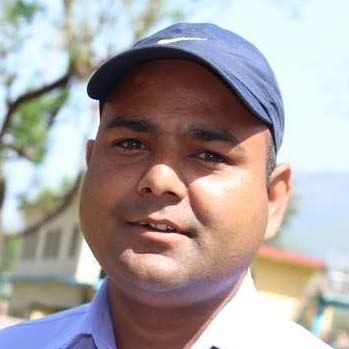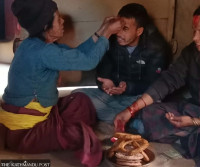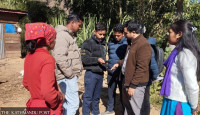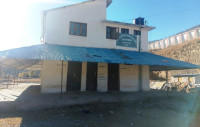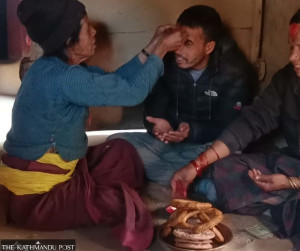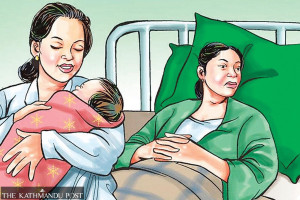Karnali Province
For Karnali’s poor, survival means leaving home
Thousands of youths from across Karnali Province migrate to India every year leaving behind villages of women, children and elderly.
Krishna Prasad Gautam
Harka Bahadur Mahar, aged 57, of Rawatgaun in Jajarkot district ekes out a living by loading and unloading goods from vehicles in the local Rimna Bazar. His three sons and as many daughter-in-laws are currently in India for work, so Harka supports his wife Manamaya and seven grandchildren as a daily-wage worker.
“The sons send some money home but it is all used to repay the loan. We were left destitute after an earthquake destroyed our house last year. My wife and I earn about Rs500-600 as daily wage earners. How can we survive with such meagre earnings?” said Harka, who has been living with his wife and grandchildren in a temporary shelter after the 6.4 magnitude earthquake destroyed his house on November 3 last year.
The Mahar family had built a six-room stone and mud house two years ago by borrowing money from neighbours and relatives. “We have yet to pay back around Rs300,000 of that loan,” said Harka. He used to catch fish, weave fishing nets and make earthen pots as his ancestral occupation, but switched to daily-wage labour after his traditional occupation could no longer manage two square meals.
Dirgha Badi, aged 58, of ward 1 of Sharada Municipality in Salyan district and his wife Jhupa crush stones into aggregates on the banks of the Sharada river. They crush a tractorload of aggregates in around seven days which sells for around Rs4,000 in the local market.
“We barely earn Rs500 a day. When we are sick and unable to work, we go to bed hungry,” said Dirgha.
Since their sons, who work in India, don’t send any remittances, the Badi couple has no choice but to continue crushing stones for livelihood.
“We cannot find other work in the village,” he lamented.
The Badi couple has been staying in a tin-roof hut built on unregistered land and have been excluded from the federal government’s People’s Housing Programme as they do not have land ownership papers.
Like the Mahar and Badi families, thousands of people in Karnali, the country’s largest and remotest province, have to struggle for their livelihood. Rampant poverty forces thousands to migrate, mainly to India, for work, posing a serious challenge to the province’s development.
The Karnali provincial government has been struggling to alleviate poverty. Its first five-year plan, announced in the fiscal year of 2019-20 set ambitious targets: slash the poverty rate from 28 percent to 18.8 percent, reduce multidimensional poverty from 51.2 percent to 25 percent, and increase per capita income from $606 to $1147.
But, by the end of the five-year plan, the poverty rate had declined to 26.6 percent, multidimensional poverty stood at 30.5 percent, and per capita income reached $997.
According to the Financial Comptroller Office in Surkhet, the Karnali provincial government spent Rs103 billion since its formation in 2017.
“But the poverty could not be reduced as expected mainly due to sluggish development, administrative inefficiency, and lack of effective monitoring mechanism. Most of the developmental infrastructures in Karnali have been constructed without a master plan,” said Durga Prasad Sapkota, a civil society leader.
“Business activities are not vibrant due to lack of modernisation of agriculture, protection and promotion of indigenous crops, collection and procession of the medicinal herbs and their markets,” said Sapkota, adding that Karnali’s development has stymied further due to lack of good transportation infrastructures.
The Fourth Nepal Living Standards Survey 2022-23 report released by the National Statistics Office in February revealed that as many as 20.27 percent of the population lived below the poverty line in the country in 2023 compared to 25.16 percent in 2011.
As per the Nepal Living Standard Survey 2022-23 report, Karnali Province's poverty rate is above the national average. Percentage of people living below the poverty line in Karnali is 26.69, second highest of Sudurpaschim Province.
Suryanath Yogi, vice-chairman of the Karnali Province Planning Commission, attributed the failure to meet targets to the Covid pandemic, political instability, problem in implementing budget, staff shortage and a national economic crisis.
“We are drafting the second periodic plan with a focus on alleviating poverty and achieving prosperity," said Yogi.
For many, migration remains the only option. Every year, young men leave Karnali in their thousands to work as labourers in India, leaving behind villages populated mainly by women, children and the elderly.
The 2021 National Census reveals a grim reality for Karnali: out of its population of 1.69 million, over 442,000 people—roughly 26 percent—are working in India.
"There is no work here. We would starve if we didn’t go to India," said Bindaman Kami, 71, of Khadachakra Municipality-4 in Kalikot. Two of his sons are currently working in Shimla, India.




 10.12°C Kathmandu
10.12°C Kathmandu